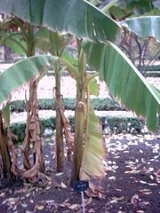
Musa basjoo
Encyclopedia
Musa basjoo, known variously as Japanese Banana, Japanese Fiber Banana or Hardy Banana, is a species belonging to the genus Musa
. It was previously thought to have originated from the Ryukyu islands
of Japan
, from where it was first described in cultivation. It is now considered more likely to have originated from China
, where it is also widely cultivated, with wild populations thought to exist in Sichuan
province.
Thus, it can be grown as far north as Zone 5a in the United states, or can be overwintered in a pot and kept growing, which is the only way it can be made to fruit in northern regions (bananas require 12 -24 months of warmth to bloom).
. In its home range in Japan, where it is thought to have been imported from China, the fibers of the plant are used to produce textiles known in Japanese
as bashōfu (芭蕉布, lit. "banana cloth").
Muša
Mūša is a river in Northern Lithuania and Southern Latvia , having its confluence with river Nemunėlis , in Latvia, near city Bauska. Mūša is a tributary of the river Lielupė. Mūša is 164 kilometres long....
. It was previously thought to have originated from the Ryukyu islands
Ryukyu Islands
The , also known as the , is a chain of islands in the western Pacific, on the eastern limit of the East China Sea and to the southwest of the island of Kyushu in Japan. From about 1829 until the mid 20th century, they were alternately called Luchu, Loochoo, or Lewchew, akin to the Mandarin...
of Japan
Japan
Japan is an island nation in East Asia. Located in the Pacific Ocean, it lies to the east of the Sea of Japan, China, North Korea, South Korea and Russia, stretching from the Sea of Okhotsk in the north to the East China Sea and Taiwan in the south...
, from where it was first described in cultivation. It is now considered more likely to have originated from China
China
Chinese civilization may refer to:* China for more general discussion of the country.* Chinese culture* Greater China, the transnational community of ethnic Chinese.* History of China* Sinosphere, the area historically affected by Chinese culture...
, where it is also widely cultivated, with wild populations thought to exist in Sichuan
Sichuan
' , known formerly in the West by its postal map spellings of Szechwan or Szechuan is a province in Southwest China with its capital in Chengdu...
province.
Description
Musa basjoo is a herbaceous perennial with trunk-like pseudostems growing to around 2–2.5 m (6.6–8.2 ft), with a crown of mid-green leaves growing up to 1.5 metres (4.9 ft) long and 50 centimetres (19.7 in) wide when mature. The species produces male and female flowers on the same inflorescence which may extend for over 1 metres (3.3 ft). The banana fruits formed are non-edible, with sparse pulp and many seeds.Cultivation
Musa basjoo has been extensively cultivated for fiber or gardens outside its natural range, into Japan and parts of Northern Europe and Britain, the United States, and Canada. Although the pseudostem may only cope with a few degrees below freezing, the underground rhizome is considered frost hardy, if well insulated with several feet of dry mulch, all the way down to -25 degrees Fahrenheit. If the pseudostem is killed, the banana will resprout from the ground where it rapidly grows to full size (15 feet) in a season under optimal conditions.Thus, it can be grown as far north as Zone 5a in the United states, or can be overwintered in a pot and kept growing, which is the only way it can be made to fruit in northern regions (bananas require 12 -24 months of warmth to bloom).
Uses
In gardens it is used as a hardy 'tropical foliage' ornamental plantOrnamental plant
Ornamental plants are plants that are grown for decorative purposes in gardens and landscape design projects, as house plants, for cut flowers and specimen display...
. In its home range in Japan, where it is thought to have been imported from China, the fibers of the plant are used to produce textiles known in Japanese
Japanese language
is a language spoken by over 130 million people in Japan and in Japanese emigrant communities. It is a member of the Japonic language family, which has a number of proposed relationships with other languages, none of which has gained wide acceptance among historical linguists .Japanese is an...
as bashōfu (芭蕉布, lit. "banana cloth").

